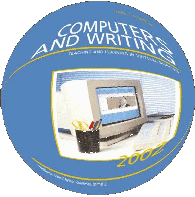 | "Our increasing use of technology has changed our reading and writing practices. This townhall focuses on those changes engendered by technology. How have the multiple forms of electronic texts changed our understanding of composing? By what processes are we building these understandings into our writing instruction? Portfolios, hypertext, synchronous and asynchronous communal texts, and 'the database essay' all have a place in this discussion." |
Michael Day -
Dene Grigar -
Johndan Johnson-Eilola -
Jim Kalmbach -
Becky Rickly -
Paul Taylor -
|
Johndan Johnson-Eilola – "Writing About Writing"
I've been asking myself (to no avail) this question for many years: What
is writing? As most rhet/comp teachers and scholars will say, it's both
a verb and a noun, a somewhat coherent set of processes and a resulting
text. This is precisely where our problems started.
I want to suggest that we begin thinking about writing from a slightly
(but crucially) different framework: WRITING AS THE RECURSIVE, SHARED,
(AND SOMETIMES ABSCONDED WITH) COORDINATION OR BUILDING OF SPACES AND
FIELDS. In other words, writers are not individuals (or even groups) who
produce texts, but participants within spaces who are recursively,
continually, restructuring those (and other) spaces.
This seems like a relatively minor (and quibbling) shift to make. After
all, haven't we been talking about collaborative writing, about social
construction, about postmodernism, about building MOOs and other virtual
spaces, for years and years? Yes, we have. But we continue to value, as
a discipline, the production of individual, discrete texts: essays,
papers, email messages, presentations, Web sites. The more interesting
and less traditionally textual examples are still too often constructed
as special instances, exceptions, or interesting thought experiments.
In part, this can be tied back to our still commonly held notion that
the production of text begins with an individual creating an artifact
(scrawling a letter in crayon, pressing individual keys [then send] on a
keyboard, etc.), then moves outward to more complex and social forms.
This tendential force – the notion that writing originates within the
writer, then is sent out – powerfully affects everything else we think
and do, discourages us (and everyone we work with) to consider writing
as separate from social activity, as separate from thought. Perhaps more
importantly, it continues to support the debilitating notion that
writing should represent some external and objective truth, that writing
is somehow an imperfect but necessary lens through which other (more
important and real) things can be glimpsed.
Here are some quick and incomplete implications of beginning with the
notion that writing is the recursive, shared coordination of spaces and
fields.
- Writing begins with the assumption of something like a second law of
communicative thermodynamics: symbols are never really created or
destroyed, it only changes form, relation, or becomes duplicated. That
is, writing doesn't spring full formed from the brow of isolated
creative geniuses, but is always the ongoing manipulation of
intertextual bits.
- Writing has no meaning outside of those fields and spaces (because it
literally *is* the fields and spaces). This, again, is something we've
argued for years: that meaning is contextual. But in this new formation,
writing is part and parcel of the context. (To think of it another way,
writing is the medium in which reality is constructed and moves.)
- Gone: The Shannon and Weaver model in which communication moves
neatly from sender to passive receiver. Instead, writing requires the
participation of the sender and receiver in order to even come into
being.
- MOOs (and, in fact, all architecture and "realworld" construction)
are texts.
- We do away with the idea that students must paraphrase quotes in
order to "make the material their own" (an idea that makes sense only if
you value individual creativity over use). Instead, research (and any
communication) could be understood as symbolic-analytic work: the
collection, filtering, connecting and disconnecting of information.
- We do away with the notion of "voice" as the distinctive, inherent
fingerprint of individual identity. Instead, we acknowledge that people
reconstruct themselves and situations within and as situations
dynamically. Some constructions might be more commonly used than others,
but all are equally valid within their own contexts (and equally valid
to be changed by appropriation, duplication, and modification by anyone
to other contexts).
- Citation is used only as a way to connect spaces/texts
rhizomatically, not (as it currently often is) to denote ownership and
false origination of ideas.
- We begin to understand communication as shared space rather than
either (a) discrete objects within space or (b) individually owned
spaces that are rented by other individuals. (These are the two
misconceptions on which currently mangled and out of control IP law is
based.)
Also: None of this is new.
There are more. And I don't believe all of them are necessarily true;
they're objects for thinking with.
 
|
|
